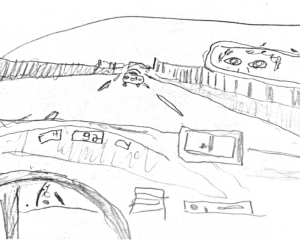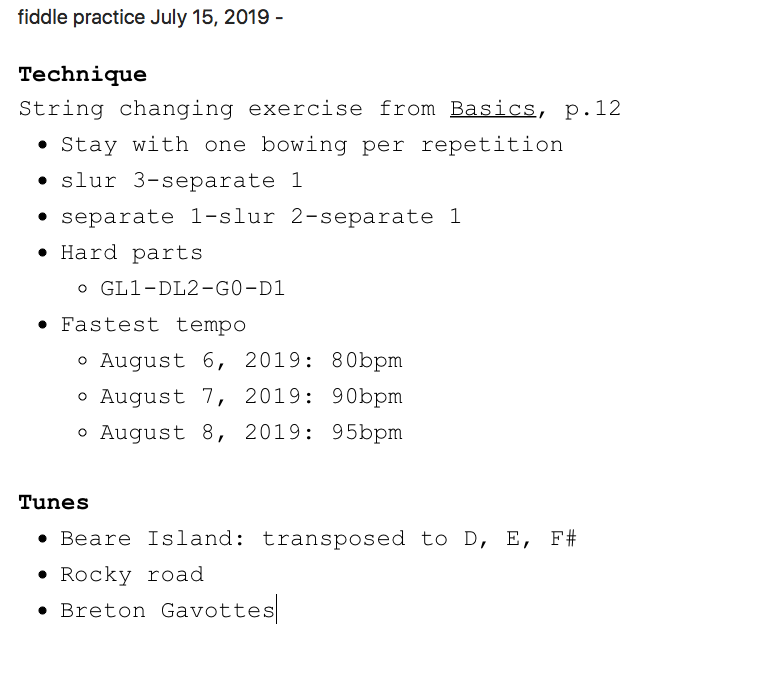“I can’t play it fast enough! How can I speed up this tune to the right speed? Will I EVER be able to do it?”
Before we get into how to play faster, I want to ask you something. Why do you want to play fast?
“Because I heard a famous fiddler play it fast.”
“I want to play faster because everyone else in the group is playing faster!”
“I want to see some noticeable progress.”
The short version of this article:
- Slow down to play fast.
- Focus on playing at a steady tempo with good sound.
- Gradually speed things up using a metronome.
- Track your fastest speed.
- Enjoy what you are doing in the present moment regardless of the speed.
Velocitation
Almost every student I’ve ever taught plays too fast. Usually, they are not even trying to play fast. There’s a driving term for this called “velocitation” (learned that when I had to do traffic school online). Velocitation is when you end up speeding on the highway without even knowing it. It happens on the open road and on the fiddle.

One of my main jobs as a teacher is to just slow people down so they can play in time with flow. When you play too fast, you may notice that the following things happen:
- There is constant stopping and starting. This is because you have not learned the tune deeply enough yet.
- Your fingers are fumbling for the notes (because your fingers cannot keep up).
- Your string changes are sloppy (because the right arm cannot keep up).
Your brain wants to velocitate. But the body needs time to learn. If you can slow down, then you’ll find you move from thinking to playing. In this way you are more likely to enter a flow state when you play. This is something you will enjoy. This what making music is all about. Allow yourself to do this. I say “allow” because it’s something you can do, you just have to allow yourself to do it.
First, focus on playing in time
Before trying to play fast, focus on simply playing in time with an external beat. This lays the foundation for playing fast.
Do this using a metronome:
You can also use a drum machine/keyboard or a play-along track, like this Bodhran play-along track (more of these in Beat Central):
Alternatively, you can play with someone who has good timing, like a teacher or a patient friend.
Start by playing small things in time with the external beat:
- Intervals
- Two-note exercises
- 3-6 note bits
- Quarters of tunes
- Whole parts of tunes
With each small part, play it in time with an external beat until it flows. Then when you assemble the tune, you’re more likely to play the whole thing at a steady pace. Alternate between parts and the whole as you see fit.
Make a practice of doing this with everything you practice. Simply play things in time. This lays the foundation for playing fast.
Speed up gradually
OK, so you get to the point where you can play things in time with an external beat. Nice going! This is not a small accomplishment. Now you’re ready to charge ahead and play that fiddle break like you heard it on the recording…
But it seems impossible. How do you get from a steady medium tempo to the breakneck speed?
You do it in the same way you learn anything: with micro-practice. Start with the first quarter of a tune and gradually speed that up. Stop when you get to the tempo where you’re falling apart. Then return to a middle-of-the-road tempo. Do this for all parts of a tune.
You might find that some parts are easier to speed up than others. I notice this a lot with in-person students. They play the easy parts fast and slow down on the hard parts. It’s these hard parts that need the most attention. They are the limiting factors for playing fast.
The speed at which you play the hardest part should be the speed at which you play the whole tune.
Say you are working on speeding up the second quarter of the B part to Arkansas Traveller, which is the hardest part of the whole tune for you.
A3-2-3-E1-E0-A3-E0-L2-1-0-A3-E1-0-A0
You are able to play that at 70 BPM (beats per minute). This means that you want to play the whole tune no faster than 70 bpm. Does that make sense?
If I’m not playing with a beat, I also will velocitate on parts that I’m good at, then slow down on parts where I stumble. I usually start to notice this and then try to focus the hard thing, gradually speeding it up:
Action step: figure out what are the hard parts of a tune, learn them thoroughly, then speed those up first.
I’ve made more metronome tracks for you. Some are at a steady tempo, some speed up (like the play-along tracks for tunes and exercises).
Track your fastest time
If you are a beginner or intermediate level fiddler, it will take a long time to speed up a tune to where you want it to be.
First of all, just accept this. It’s ok to play slowly at first!
Second, if you track your fastest time on a given day, then you will be able to speed things up in a more painless and methodical way. If you tracked your fastest speed today it means you can try it a teeny bit faster tomorrow.
Say the fastest you can play Arkansas Traveller today is 70 bpm. Tomorrow when you practice, start at an easy tempo and then incrementally work up to 70 bpm. When you get there, try to do it a little faster, maybe 75 bpm. If you can play it with flow there, try 80 bpm. If you stop and start at 80 bpm, then mark 75 bpm as your new fastest time.

Find a way to track your speeds that feels right for you. This is incremental learning, the same fiddlosophy I recommend throughout FiddleHed.
The Tai-chi Fiddle Method
One way to get better at playing fast is to play things at a very slow tempo with an external beat. This is challenging. If you can play something very slowly at a steady pace, then your body is more precisely trained to do each action. You end up knowing that piece or technique more deeply. Just as in Tai-chi, playing something really slow allows you to move from thinking to playing so that you enter a state of flow.
Using the example of the fourth quarter of Arkansas Traveller, try playing it at 40 bpm. It starts to sound weird! But when you play it at a faster speed again, you’ll find you have more command of what you are doing.
The Jedi-mind trick to playing fast

When you are trying to speed something up, first see if you can clearly “hear it in your head”. The term for is audiation.
This will be especially helpful with the difficult parts. In fact, the problem all might be that you don’t know exactly what you are supposed to be doing. If you can audiate a piece of music, you have a much greater chance of playing it correctly. And if you can hear the music in your head, it will be easier for you to speed it up.
I made a dedicated lesson on Audiation as well as a library of tuning exercises to practice it.
Playing with others who play fast
What to do when you can’t keep up with others who are playing fast?
This is discouraging. I feel your pain.
Ask yourself, is there someone I can play with who will be willing to play more slowly? Perhaps a teacher, or a musician friend. Maybe there’s someone who would be happy to play guitar at a slower speed for you. There are also slow player sessions. If you can’t find this in your area, you might want to see if there’s anyone else interested in meeting to play tunes more slowly.
If there is a group of people you really want to play with, I suggest thoroughly learning the songs and tunes they tend to play. Try to speed up one tune at a time in the gradual method described above.
End on a high note
Once you have played a tune through at your fastest speed, I recommend you end your practice by playing it at a more comfortable medium speed. This is a way of “sealing it in” which allows the body and mind to relax. The tune will probably sound better. You’ll feel good about the work you’ve done and have more confidence in yourself as a fiddler. You’ll look forward to playing again tomorrow.
Fiddlosophy
And more generally, see the beauty in what is happening in this moment. How cool is it that you are making music? How amazing is it that you can learn something new at any point in your life? Try to see this so that you are not unsatisfied with where you are. Hear the beauty in playing these tunes more slowly. It’s fun to speed them up, but this simple beauty is often lost when advanced players rip through the tunes.
Practice with drones and looping. In this way, you will enjoy playing things more slowly. This, in turn, will help you when it comes time to speed it up.
This is the fiddlosophy part of it all. How can you be content with who you are and what you are doing? How can you balance effort and acceptance? There is a mysterious dance between these two forces. When you learn anything, you take part in this dance. It just so happens that learning the fiddle is a fun way to practice contentment. Yeehaw!
Further Reading
Six Ways To Overcome Fiddle Frustration
Two ways I can help you level up your fiddling
- Sign up for the FiddleHed newsletter below.
- Sign up for the Free Two-week Trial. You’ll get full access to all courses and group lessons. Plus, I’ll send you some free lessons tailored to your current skill level.
Thanks for being here 🙏

